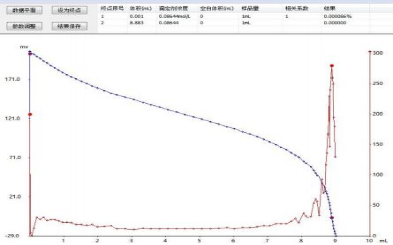July 02, 2025
Tag:
Preface
Boric acid serves as a PH buffer in the electroplating solution for electronic components. It is an essential component in the electroplating solution to prevent sudden PH increases or decreases during the electroplating process, which may affect the quality of electroplating.
This method uses sodium hydroxide as the titrant, enhances the acidity of boric acid with mannitol, and employs a PH composite electrode as the measuring electrode. The content of boric acid in it is detected by the JH-T6 fully automatic potentiometric titrator. The detection results are highly accurate, the detection efficiency is fast, it is easy to operate, and at the same time, it reduces human interference and improves the stability of the detection.
Ii. Instruments and Reagents
2.1 Instruments
JH-T6 fully automatic potentiometric titrator, PH composite electrode, analytical balance, etc
2.2. Reagents
Mannitol (analytical grade), sodium hydroxide standard solution (0.1mol/L), purified water.
Iii. Experimental Methods
3.1 Analysis Steps
Accurately measure 1.0mL of the sample with a 1mL pipette into a titration cup. First, add 25mL of water, then 25mL of mannitol solution, and finally 25mL of water. Start the pre-edited method, titrate with the calibrated sodium hydroxide solution until the potential suddenly crosses the endpoint, and record the amount used. At the same time, conduct blank experiments.
The parameters of the titrator are set as shown in Table 1
Table 1 Titration Parameter Settings
| Titration type: | Dynamic titration | method name: | Chloride content determination |
| Burette volume: |
10mL |
Sample measurement unit: |
g |
| Working electrode: | Composite silver electrode | Reference electrode |
無(wú) |
| Stirring speed: |
8 |
Pre-stirring time |
5s |
| Display unit: |
mV |
End volume: |
20mL |
| Electrode equilibrium time: |
4s |
electrode equilibrium potential: |
1mv |
| Titration speed: | standard titration | Equilibrium potential |
6mv |
| Pre-titration addition volume: |
0 |
Minimum addition volume: |
0.02mL |
| Potential spike: |
500 |
pre-controlled mv value: |
無(wú) |
| Correlation coefficient: |
35.5 |
Result unit: |
g/L |
|
Titrant name: |
Silver nitrate solution | Theoretical concentration: | 0.1(calibrated concentration) |

Iv. Results and Discussion
4.1 Experimental Results
The experimental results are shown in Table 2
Table 2 Test Results
| Sample name |
Sampling volume mL |
c(AgNO3) mol/L |
Blank volume V0 /mL |
Titration volume V1 /mL |
Chloride g/L |
Average content g/L |
RSD(%) |
|
Solution |
1 |
0.0864 4 |
0.161 |
8.883 |
46.593 |
46.304 |
0.7023 |
|
8.763 |
45.952 |
||||||
|
8.841 |
46.368 |
4.2. Conclusion
The determination of boric acid content by potentiometric titration is rapid and has good data repeatability, which improves the accuracy of the detection data and reduces the errors caused by human operation.
References
[1] Wan Zhuo. Detection Methods for Nickel Ions, Chloride Ions and boric acid Contents in Electroplating Nickel Solution [J]. Industrial technological innovation.


Contact Us
Tel: (+86) 400 610 1188
WhatsApp/Telegram/Wechat: +86 13621645194
+86 15021993094


